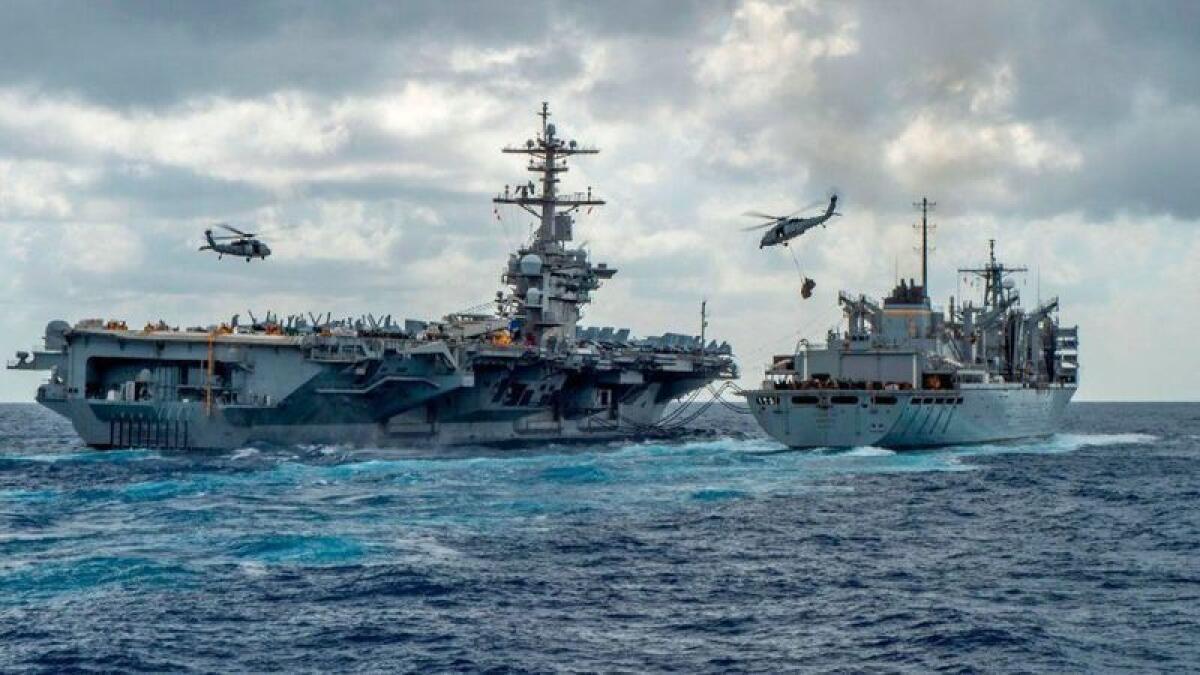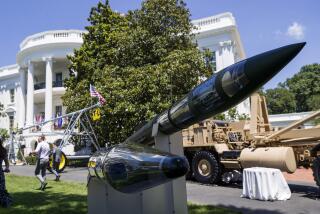Pentagon asks Trump to send several thousand more troops to Mideast as Iran tensions grow

Reporting from Washington — The Pentagon has asked the White House to send several thousand more troops, Patriot anti-missile batteries and warplanes to the Middle East to boost U.S. defenses against Iranian threats, senior U.S. officials said Thursday, in a sign of the growing friction with Tehran.
If approved, the reinforcements would represent another course correction by President Trump, who has given mixed signals to Iran, most recently appealing to Tehran’s supreme leader to open direct negotiations with him only days after he threatened punishing retaliation if Iran attacked U.S. targets.
The proposed escalation includes an Air Force fighter squadron, several additional warships and special reconnaissance aircraft to help keep tabs on Iranian forces. The White House announced on May 6 that it was sending the Abraham Lincoln carrier strike force and four B-52 bombers to the region, citing growing threats from Iran.
Trump, who was scheduled to meet with acting Defense Secretary Patrick Shanahan and Gen. Joseph Dunford Jr., chairman of the Joint Chiefs of Staff, did not say whether he had approved the request.
“I don’t think we’ll need it but if we need it we’ll be there with any number we need,” Trump told reporters at the White House. “I would certainly send troops if we need them.”
Gen. Kenneth F. McKenzie Jr., the top commander of U.S. forces in the Middle East, is especially interested in adding Patriot anti-missile batteries to help defend U.S. troops, facilities and allies in the region, according to a U.S. official who spoke on condition of anonymity to discuss internal planning.
One Patriot battery is already headed to an undisclosed country in the area, but McKenzie is interested in beefing up anti-missile protection more broadly, the U.S. official said.
“We are looking at … things that we can do to enhance force protection in the Middle East” and the options “may involve sending additional troops,” Shanahan told reporters at the Pentagon.
Tensions between Washington and Tehran have run high since U.S. officials received intelligence indicating that Iranian security forces had loaded missiles aboard small boats, raising fears that they planned to carry out attacks against oil tankers or other shipping in the Persian Gulf.
U.S. surveillance of Iran’s naval bases and military installations showed a high state of alert by Iranian cruise missile batteries and other maritime forces along the strategic waterway. That partly prompted the Pentagon request for more forces, although it wasn’t clear whether the Iranian moves were in response to the growing U.S. military operations.
“They continue to operate at a high level,” moving missiles, air defense systems and small boats that Iran has long used to threaten American warships, the U.S. official said.
U.S. intelligence agencies believe Iran probably does not want a military confrontation. But hard-line units from the Islamic Revolutionary Guard Corps may try to use proxies and unconventional tactics for low-level attacks against the U.S. and its allies, U.S. officials said.
Trump’s decision last month to designate the powerful Revolutionary Guard as a foreign terrorist organization under U.S. law has especially inflamed tensions. A tightening tourniquet of U.S. sanctions has constricted Iran’s economy and oil exports, which reduced a crucial income stream for the Revolutionary Guard.
U.S. officials claim evidence shows that Iran was responsible for apparent sabotage attacks that damaged four oil tankers at anchor off the United Arab Emirates on May 12. The administration has not made public any evidence implicating Iran.
U.S. officials also suspect Iraqi militia fighters loyal to Iran of firing a rocket in Baghdad on Sunday night that landed less than a mile from the American Embassy.
In recent years, Iran has invested substantially in anti-ship cruise missiles, posing a greater risk to oil tankers and to warships.
Of particular concern is Iran’s ability to block access or free passage in the Strait of Hormuz, the narrow choke point in the Persian Gulf through which one-fifth of the world’s oil shipments pass.
Navy officials say Iran might be able to temporarily block tanker traffic in the strait using anti-ship missiles and other weapons, but U.S. commanders say they can reopen the waterway quickly if necessary.
During its 1980-88 war with Iraq, Iranian forces mined shipping routes and threatened to close the strait. When the Samuel Roberts, a U.S. guided-missile frigate, was severely damaged by an Iranian mine in 1988, the Reagan administration ordered the destruction of two Iranian oil platforms, an Iranian frigate and a number of smaller armed boats.
The current American buildup has prompted fierce criticism by Democrats in Congress, who warned that hard-line Iran critics in the White House, including national security advisor John Bolton, were seeking a military confrontation with Iran without authorization from Congress and without sharing intelligence that Tehran was in a threatening posture.
“Right now the administration is involved in what I would characterize as a series of blind, senseless escalatory measures with respect to Iran with no ending, with no strategy,” Sen. Christopher S. Murphy (D-Conn.) said Thursday in an event with Win Without War, an activist group “The danger is that a mistake … turns into a war.”
The Pentagon already has as many as 80,000 troops in the Middle East, including roughly 14,000 in Afghanistan, 5,000 in Iraq, 2,000 in Syria, 10,000 in Kuwait and 10,000 in Qatar. More than 1,000 Marines are aboard the Kearsarge, an amphibious assault ship, in the North Arabian Sea.
Shanahan played down published reports that the Pentagon was seeking between 5,000 and 10,000 additional troops.
“I woke up this morning and read that we were sending 10,000 troops to the Middle East and read more recently there was 5,000,” he said. “There is no 10,000 and there is no 5,000. That’s not accurate.”
Shanahan and Secretary of State Michael R. Pompeo held a closed-door briefing on Iran for lawmakers Tuesday. They summarized the intelligence and emphasized that their aim in sending additional forces was to deter attacks from Iran, not to provoke a crisis.
But Shanahan has sent conflicting signals, telling reporters before Tuesday’s briefing that the U.S. military moves had forced Iran “to recalculate” and that the potential for attacks on Americans were “on hold” as a result
On Thursday, Shanahan again warned that Tehran might strike, suggesting it could misinterpret the U.S. military moves as a threat.
“This gets back to the risk of Iranian miscalculation,” he said. “So we’re very protective of our men and women. We’re very protective of our interests in the region.”
The White House recently said Trump would nominate Shanahan as secretary of Defense, so he has to worry about congressional views since he would require confirmation by the Senate.
Sen. Richard J. Durbin (D-Ill.) said Thursday it was up to Shanahan to prevent Trump from accidentally sparking a war.
“The secretary of Defense in the Trump administration has a special responsibility to advise a president with no experience in national security and a limited grasp of the life-and-death decisions he must make,” Durbin said.
He added, “It remains to be seen whether Patrick Shanahan is up to that job.”
More stories from David S. Cloud »
More to Read
Get the L.A. Times Politics newsletter
Deeply reported insights into legislation, politics and policy from Sacramento, Washington and beyond. In your inbox three times per week.
You may occasionally receive promotional content from the Los Angeles Times.











